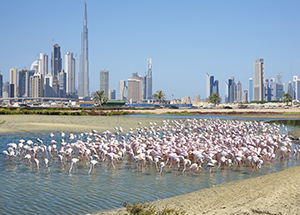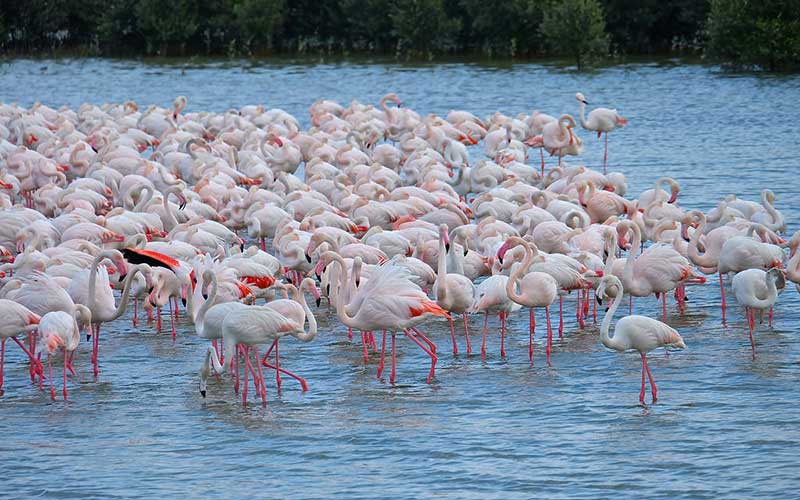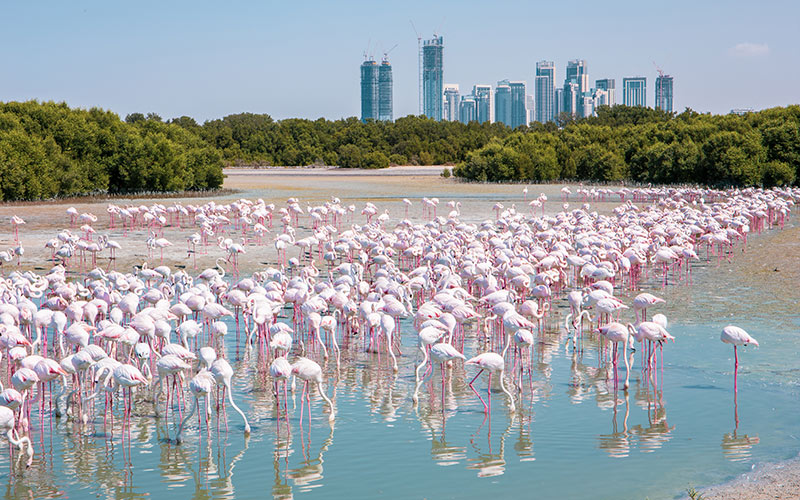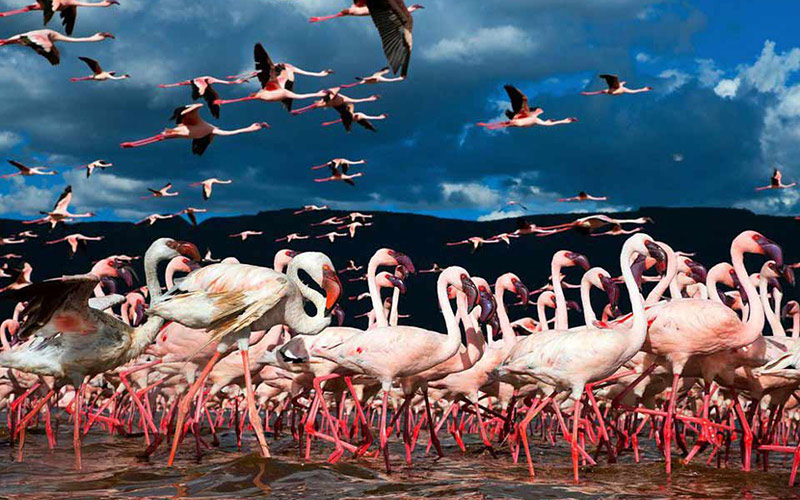Dubai is more than just a most desirable hotspot for the touring millions that hit the city each year – it’s also a default destination for migrating birds of every description! Can anyone imagine that just a little distance away from the glamorous city are ancient wetlands containing a wildlife haven? It’s true –
Ras Al Khor Wildlife Sanctuary
is a precious protected bird sanctuary home to over 25,000 water birds belonging to more than 150 species. Want to know more?
Ras Al Khor: Location, Address and Timing
Hides are open from 7:30 hrs. to 17:30 hrs. in the winter months, and from 6:00 hrs. to 18:00 hrs. from April to September.
Entry Fee
Free Entry
Dubai’s Amazing Wetland Wildlife Haven!
Ras Al Khor Wildlife Sanctuary Dubai is a blissful six-kilometer-long mixed stretch of intertidal mudflats, salt flats, lagoons, scrublands, and ancient mangroves. Situated right at the mouth of Dubai Creek, this sanctuary provides a safe abode to birds that come to Dubai in winter. What’s more, this enchanting bird sanctuary also has over 500 species of flora and fauna! For any avid birdwatcher, this bird sanctuary is a real treat. There’s no better sight than watching the sky turn pink when thousands of pink flamingos take to the heavens at sunset. Arm yourself with binoculars and watch some fascinating bird species that stop here on the east African–west Asian flyway.
The Bird Watching Hides of Ras Al Khor!
Three platforms, or hides, as they’re called, have been built complete with binoculars so visitors can enjoy watching the birds feed and take flight. The two sides are open to visitors from Saturday to Thursday, from 9 a.m. to 4 p.m. Note that the hides are completely fenced in. There is no direct access except via the set routes.
- Flamingo Hide:
The flamingoes roost close to the hide, including the elusive Greater Flamingo, so you have a good view. Catch the enchanting sight of flamingoes engaged in voracious feeding, facilitated by the park rangers in the afternoon. The flamingos are good about sharing their reserve with other bird species, such as grey herons, eagles, marsh harriers, avocets, pintails, ringed plovers, teals, kingfishers, snipes, and spoonbills. These birds flock to the hide to feast on the delicious queenfish and the meter-long milkfish that throng the nutrient-rich waters. Look up towards the Zabeel fish ponds, and you can watch the Great Spotted Eagles and other raptors soaring overhead.
- Mangrove Hide:
This hide overlooks the rich mangrove forest on the southern edge of Ras Al Khor. The Mangrove Hide has a full-time guard to watch over the birds. The roosting birds wade into the water to catch their fish, directly under the mangroves. A fabulous Leica telescope is made available from 10 a.m. to 3 p.m. for visitors. The Mangrove Hide is a great place for wading birds such as Pacific Golden Plovers and Broad-billed Sandpipers. The Broad-billed Sandpipers visit the Mangrove Hide from April to July. You might see more than 403 birds at the Mangrove Hide, making it one of the best things to do in summer. Raptors roam over the Mangrove Hide parking lot, and Greater Spotted Eagles are usually available to watch from October to April. Several rare birds are spotted here: the Red-crested Pochard, Demoiselle Crane, Great Crested Grebe, Lesser Spotted Eagle, and the Pied Kingfisher.
- Lagoon Hide:
This hide offers an astonishing perspective to spot various bird species, including raptors and waders. Its perfect setting in the sanctuary makes it a favorite of avid bird lovers.
Also Check: Best Things to do in Dubai in Summer
How and When to Visit Ras Al Khor
- Visiting the Sanctuary:
Grab a taxi or rent a car from the closest metro station to get to the sanctuary. Drive along the Dubai to Hatta main motorway (E44) and head towards Al Ain on E71. Watch out for signposts for Hatta, and then turn back on the Dubai – Hatta Road towards Dubai. Watch out for a turnoff to the sanctuary from the 4-lane highway along the way, and enter it. It’s best to visit the Mangrove Hide during low tide when the mangroves are above the water. Any time of the day is suitable, as long as the tides are low. You can walk or drive to the Flamingo Hide from the Mangrove Hide, a distance of 2.73 km. However, it is not permitted to walk or drive to the Mangrove Hide from the Flamingo Hide.
- Permits:
If traveling solo or with a group smaller than five members, you don’t need a permit to visit the sanctuary. However, before the visit, all media members, group tours, organizations, and academic institutions must obtain a permit from www.dm.gov.ae before the visit. It’s best to apply at least three days prior to the visit, as the organizers require at least two working days to process your permits. Apply directly to the Marine Environment & Wildlife Section, Environment Department, Dubai Municipality. Once you receive the electronic permit, print it out and provide a copy to the sanctuary staff when you arrive.
FAQs
1. What is the mission of RAKWS?
RAKWS, categorized as an Important Bird Area (IBA), exists to safeguard rare and unique flora and fauna and preserve their natural habitat.
2. Where is Ras Al Khor Sanctuary situated?
It is in the wetlands at Dubai Creek’s end, spanning over 6.2 square kilometers. The nearest metro stations to reach the sanctuary are Al Jadaf and Creek stations on the Green Line. There are feeder buses from the station that transfer you to the cover. If you take the bus, board bus number 53 or 64 to get there. You can also hire a cab for hassle-free access to the sanctuary.
3. What are the main bird species that thrive in the sanctuary?
RAKWS is a safe abode for about 50 species of flora and over 250 species of fauna. The major is the pink flamingoes, whose numbers peak in winter. You can also spot several wetland bird species, including grey heron, grey plover, sandpiper, black-headed gull, mallard, imperial eagle, and pintail, to name a few.
4. Is Ras Al Khor Sanctuary open to the public?
It is open to the public, and the entry here is free here. You can log on to Dubai Municipality’s website from Sunday to Thursday to sign up for guided tours.
5. Do I need to adhere to specific rules for visiting Ras Al Khor Wildlife Sanctuary?
You must take into consideration the following during your RAKWS visit:
- Refrain from any act that causes damage or disturbance to the sanctuary’s rich and protected flora and fauna.
- Don’t pollute or litter this well-preserved area’s air, soil, or water.
- It is strictly prohibited to hunt and kill its inhabitants or introduce any species that are not indigenous to this protected area.
- Don’t attempt to feed birds.
- Avoid being loud and adhere to the restrictions regarding noise levels, as it is a silent zone.
6. Does Dubai have other animal attractions?
Yes, Dubai has some of the most captivating animal attractions, from Dubai Safari Park with several themed sections to Dubai Aquarium & Underwater Zoo inhabiting over 33,000 marine creatures to Dubai Dolphinarium with adorable dolphins and seals.
Conclusion
‘Ras Al Khor’ literally translate to ‘Cape of the Creek’. It’s a captivating and unexpected wilderness enclave in the middle of the city’s traffic and sprawling urban infrastructure. The 620-hectare Ras Al Khor sanctuary is situated at the very head of the 14-kilometer-long Dubai Creek. Even if you are not a bird watcher, the amazing ecosystem of the sanctuary is worth a visit. Observe how the sabkhas saline flats, the intertidal mudflats, and mangroves co-exist with lagoons, pools, and tiny islands between the Arabian Gulf and the Al Awir Desert. It’s truly incredible!




